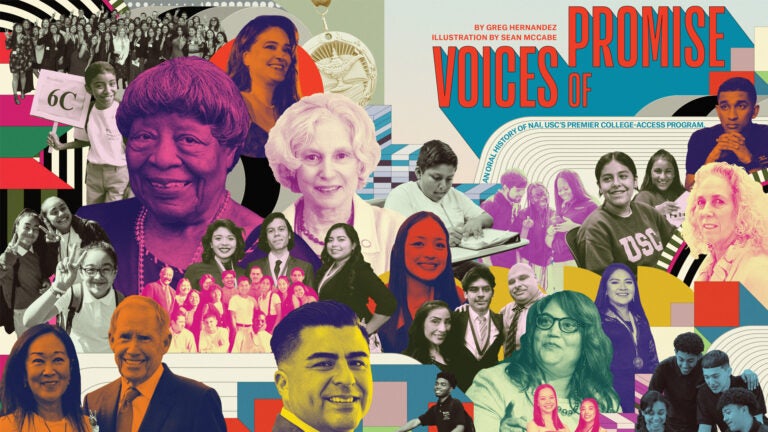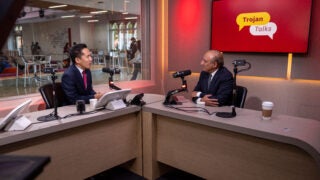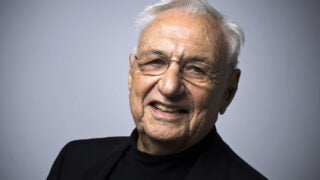
NAI is operated by USC Educational Partnerships in the division of University Relations; students who live in the neighborhoods closest to USC’s University Park and Health Sciences campuses apply online and are chosen by a selection committee. (Illustration by Sean McCabe/ Photos courtesy of the McMorrow Neighborhood Academic Initiative; NAI event photos by Gus Ruelas, Steve Cohn, David Sprague, Rich Schmitt, Michael Owen Baker ; NAI lifestyle photo by Sarah M Golonka; Manning photo courtesy of Sylvia Manning; McFadden photo by Greg Hernandez)
Voices of Promise: An oral history of the Neighborhood Academic Initiative
Trojans reflect on USC’s premier college-access program, the Neighborhood Academic Initiative, as it celebrates its 35th year.
Luis Campa and his middle-school classmates got some puzzled looks when checking out books at Doheny Library and while walking to their morning math and English classes at USC’s University Park Campus in the early 1990s.
“We would get questions like, ‘What are you guys doing here? You’re little kids!’” Campa says. “We had USC IDs but we’d have to explain, and sometimes staff members would call someone to double-check.”
Campa and his peers were among the first local middle schoolers to take part in the then-fledgling college access program now known as the USC Leslie and William McMorrow Neighborhood Academic Initiative (NAI).
Since its launch 35 years ago, NAI has guided nearly 1,700 scholars who grew up near USC’s University Park and Health Sciences campuses through a seven-year college prep journey starting in sixth grade by offering academic support and resources to prepare students for college admission and the academic rigors of university life.
Students attend early-morning weekday classes at a USC campus before their regular school day begins. They also attend Saturday sessions that provide resources such as academic enrichment, SAT preparation and personal development programming. And by holding workshops for parents and caregivers on everything from nutrition to financial literacy, NAI equips them with tools to nurture their children’s academic success. The program’s investment in students is hugely successful: NAI has a 100% high school graduation rate and 99% college graduation rate.
Since its launch 35 years ago, NAI has guided nearly 1,700 scholars who grew up near USC’s University Park and Health Sciences campuses through a seven-year college prep journey starting in sixth grade.
NAI: Early days
In the late ’80s, USC’s Vice Provost of Educational Affairs Barbara Solomon saw a lack of diversity in higher education and wanted to do something about it. Solomon, who later became the first Black dean at USC, teamed with then-Undergraduate Vice Provost Sylvia Manning to lay the groundwork for the rigorous academic program.
SOLOMON: We wanted students to develop the skills to succeed. We [first] started with ninth through 12th grade, but it was soon apparent that we could do better if we included students at an earlier age. Then, if we worked with ninth or eighth graders, they [sometimes] had siblings who were also interested.
CAMPA, a member of the second NAI cohort and a 2002 USC graduate, founder and president of the NAI alumni association: We didn’t know what the heck NAI was about at first because there was no marketing behind it and nobody knew about it. The principal and the teachers would pick the students they thought would excel in this type of program. Now it’s different. So many people know about NAI and want to apply.
KATE McFADDEN, a teacher at James A. Foshay Learning Center for 36 years who has mentored NAI students since the beginning: When we first started, the kids began taking AP exams and no one passed — some didn’t even finish the essays. But it was OK, because they were taking the test. Then a few kids passed. Now, I talk to my students and they’re like, “Oh yeah, we finished all the essays.” It’s amazing to see the level of educational rigor grow and the expectations that the kids have for themselves.
KIM THOMAS-BARRIOS, USC senior vice president of educational partnerships: By the 12th grade, they have AP Calculus and AP Literature. We pepper the journey with support because we know what is needed: extra time on English and math. Those are the twin towers to get you into college. You’re going to read a lot, and you’re going to write a lot.
Since the first graduating class in 1997, nearly 1,700 seniors have completed the NAI journey and attended college; 487 of them are now Trojan alumni. Others have attended such schools as Harvard University, UCLA, Stanford University and University of California, Berkeley.
There are sacrifices like having to miss family gatherings on Saturdays and having people say, “You go to school on Saturday? You should be having fun!” I would say, “This is good for me! I’m going to be going to USC.”
Alexis Jacquez, 2025 Woodrow Wilson senior high school graduate and USC class of 2029
A family affair
Family support is integral to NAI’s success; parents and caregivers must attend three-hour Saturday morning sessions held more than a dozen times a year. The programs cover nutrition, wellness, financial literacy, communication, critical conversation and ways to build and maintain a culture of academic excellence at home.
SOLOMON: We knew the program needed to have the continuous involvement of parents or at least a parent surrogate if we were going to require students to be in attendance after school and on the weekends. Parents needed to have a way of connecting.
THOMAS-BARRIOS: Parents want the best for their child, so they are willing participants. We’ll talk about all the things that could knock a kid off the pathway. If you’re going to go visit grandma for a month because grandma’s sick, where is the kid going to be? They can’t be out of school for a month. That’s something that we are very strict about. It’s about being on time, not being absent, and of course, getting all your assignments done. You don’t miss anything — that’s the expectation.
GUILLE AMBROZEVICIUS, whose son, Leo, is a 2025 NAI graduate: Once he started NAI, it just became part of my son’s life. It’s part of our lives. We’ve always worked our travels around his NAI schedule. It came before a baseball game, before a soccer game, before anything that he was playing. He knew he had NAI first, and it was nothing that he was ever upset about.
ALEXIS JACQUEZ, 2025 Woodrow Wilson senior high school graduate and USC class of 2029: There are sacrifices like having to miss family gatherings on Saturdays and having people say, “You go to school on Saturday? You should be having fun!” I would say, “This is good for me! I’m going to be going to USC.”
Extending NAI’s reach
In 2018, Leslie and William McMorrow presented NAI with a transformative naming gift that was the largest-ever donation to USC’s community outreach programs. It ensures that a larger number of students can participate in NAI well into the future.
Up until now, graduates have come from Foshay Learning Center and Woodrow Wilson and Abraham Lincoln high schools. Starting this fall as part of an expansion into South and West Los Angeles, NAI will add students from Crenshaw High School and Susan Miller Dorsey High School to its cohorts.
SAMUEL GARRISON, senior vice president of University Relations: Leslie and Bill McMorrow are NAI’s guardian angels and two of the most giving people that I’ve ever met. Their love for USC, for NAI, and most importantly for the children in the program is humbling. Without their support, the program would certainly not be nearly as successful as it is.
WILLIAM McMORROW, a two-time USC alumnus and NAI benefactor: NAI is really the most rewarding thing I’ve ever been involved in. I’m just a little piece of this thing. It’s the support of the leadership at USC. It’s Kim Thomas-Barrios and her leadership for more than 20 years that is really important, as is the staff at NAI. Roughly half the kids [last] year got accepted to USC. Being around this campus and seeing what goes on here, it really makes them feel great.
NAI is really the most rewarding thing I’ve ever been involved in. I’m just a little piece of this thing.
William McMorrow, NAI benefactor
Persevering through COVID-19
One of the most challenging periods in NAI’s history began in March 2020 when the COVID-19 pandemic prevented in-person classes and meetings.
But some students faced far deeper struggles than keeping up with their studies. NAI staff saw an unprecedented rise in the demand for services from students and their families. The coronavirus also claimed the lives of three NAI parents, who in each case was the family’s primary breadwinner.
GARRISON: NAI continued because of the amazing staff that pivoted within days to continue the program entirely online. Staff focused on helping our scholars through one of the most challenging and disruptive periods of their lives. The team provided mobile hotspots as well as food, mental health resources and even in some cases helped pay for funerals.
THOMAS-BARRIOS: Our staff are beautiful people with beautiful hearts. They took on a huge commitment during the pandemic.
JACQUEZ: It was difficult to join NAI during the pandemic because of everything going on. But I kept my focus on the main goal which was to succeed and get to college. I was going to be prepared. By my sophomore year, we were able to transition from Zoom and meet our teachers and others in our cohort in person. I was able to form what I hope will be lifelong friendships.
Motivated for the journey
NAI is operated by USC Educational Partnerships in the division of University Relations. In NAI’s early days, teachers and principals hand-picked students for the program. Now, as word has spread about the success and rigor of the program and demand has grown, students who live in the neighborhoods closest to USC’s University Park and Health Sciences campuses can apply online and are chosen by a selection committee.
The majority of the program’s scholars become first-generation college students.
JACQUEZ: When I was a student at El Sereno Middle School and Magnet Center, I knew NAI was a program that could help me eventually become college-bound. It was a big deal and so competitive because everyone wanted to be a part of it.
THOMAS-BARRIOS: Fifth-grade teachers let us know that they tell students about the program — before we even get there! And the students tell their parents. We ignite the imaginations of the kids, and something just touches the parents in their hearts.
AMBROZEVICIUS: My son Leo was nominated by his fifth-grade teacher, and he pretty much started the process on his own. He started doing his essays, he filled out the application, he wrote everything he needed to write, all on his own. He presented it to us at the point where he needed to have his interview. It just surprised us. We took the time, we did some research, and it is such an amazing program.
McFADDEN: Students come in ambitious and goal-oriented. They are willing to put the hard work in.
An enduring legacy
Each spring, a location at the University Park Campus is transformed into an elegant venue for an annual gala to celebrate the culmination of NAI scholars’ seven-year journey and the beginning of their university life.
Although long retired, Solomon tries to never miss the gala; this year she was seated at a prime table. She enjoyed a steady stream of visits from Trojan attendees who were eager to greet the education trailblazer to whom Garrison later paid tribute during his remarks.
SOLOMON: I felt amazed at the size of the crowd and appreciative of the NAI grads and their proud families. The presence of so many hardworking staff, administrators and civic leaders reflected the high value placed on what the program has become.
JACQUEZ: [At our gala], my heart was filled with so much joy because I was thinking about everything I worked hard for. I got to the end goal. Others also reflected on the influence NAI has had on the lives of students and their families over the years.
McFADDEN: I’ve taught everything from seventh grade through 12th grade. I’ve seen the impact of the program not just in the kids, but on campus and in the community. It was a culture changer at our school. We have a college-going culture now. The level of rigor that students expect in their classes is very high. Teaching in the NAI program is the high point of my career. I’ve taught children of students that I had, and so the impact has been very strong, very deep.
McMORROW: These young people are so extraordinary, and their parents make such sacrifices. Not to be too corny, but it’s what makes this country great. They are truly the future of the country.
THOMAS-BARRIOS: It’s amazing that for more than three decades, USC has reached so deeply into the community that surrounds both campuses. It’s such a selfless act for a major university to be able to open its arms so wide in a way that really changes the trajectory of families.



